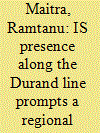|
|
|
Sort Order |
|
|
|
Items / Page
|
|
|
|
|
|
|
| Srl | Item |
| 1 |
ID:
150813


|
|
|
|
|
| Summary/Abstract |
Locked in fierce battles with Russia, Iran, Syria and a
hesitant United States and trying to protect the territory
it seized in the Levant, the so-called Islamic State of
Iraq and Syria (ISIS) is losing ground rapidly. According
to an IHS Markit report released on 9 October, the
Islamic State’s caliphate shrank during 2015 from 90,800
km2 to 78,000 km2, a net loss of 14 per cent. And in
the first nine months of 2016, that territory shrank by
another 16 per cent. As of 3 October, the Islamic State
was left with control of roughly 65,500 km2 in Iraq and
Syria, an area roughly the size of Sri Lanka, the report
notes.
As the Syrian troops, under cover of heavy Russian
air attacks, have begun to close in on areas held by
ISIS and other rebel groups, it is likely that the socalled
Islamic State will continue to lose ground in the
coming months, stalling the group’s growth in that
region. Yet with thousands of fighters – most of whom
are Arabs, fortified by a large retinue of Caucasians
and central Asians and a smattering of fighters from
elsewhere – ISIS may shrink but is not likely to vanish.
Carrying black flags and promoting a hateful brand of
anti-Shi’a Islam, this virulent group could show up in
force in those Islamic countries where governance is
weak. One such location could be the Maghreb region
of north Africa; another is the virtually ungoverned
region that stretches between eastern and south-eastern
RAMTANU MAITRA
22 January 2017. Volume 20. Number 74. AAKROSH
Afghanistan and Pakistan’s Federally Administered
Tribal Area (FATA).
In fact, available ground reports indicate that
alleged followers of ISIS have already begun to appear
in eastern Afghanistan under the name of the Islamic
State in Khorasan Province (ISKP). Though they are
few in number, disunited and lacking both known
sponsors and known connections to ISIS at this time,
the emergence of these fighters over the past several
years seems to be prompting something of a realignment
in the greater south Asia region vis-à-vis the Taliban.
In particular, Iran, Pakistan, China, Russia and Kabul
appear to be converging around support for that
Pashtun-dominated terrorist grouping – which has been
viewed for more than a decade as the primary obstacle
to peace in war-torn Afghanistan by both Kabul and
its various allies – as a bulwark against the ISKP and
Islamic State inroads. What is going on? What is at
stake? What do these developments actually mean? For
answers, we need to take a much closer look.
|
|
|
|
|
|
|
|
|
|
|
|
|
|
|
|
|
|
|
|
|